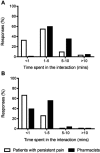Counseling interactions between patients living with persistent pain and pharmacists in Australia: are we on the same page?
- PMID: 31496787
- PMCID: PMC6689145
- DOI: 10.2147/JPR.S199017
Counseling interactions between patients living with persistent pain and pharmacists in Australia: are we on the same page?
Abstract
Background: People living with persistent pain in Australia often cannot access adequate care to manage their pain. Therefore, as the most accessible healthcare professionals, community pharmacists have an important role to play in helping to improve patient outcomes. Hence, it is important to investigate patient needs and expectations in terms of counseling interactions with pharmacists, along with pharmacists' approach to counseling interactions with these patients.
Method: The nature of patient-pharmacist counseling interactions was explored with seven patients (one focus group), and 10 practicing pharmacists (two focus groups, three semi-structured interviews). The themes identified informed the development of an online survey that was advertised online to patients and pharmacists across Australia.
Results: A total of 95 patients and 208 pharmacists completed the survey. Overall, more than half of patients (77/95) were satisfied with the care provided by their pharmacist, but only a third (71/205) of pharmacists were satisfied with the care they provided to patients. The majority of patients (67/94) reported that pharmacists provided good information about medications. This aligned with pharmacists' responses, as most reported focusing on medication side effects (118/188) and instructions for taking pain medication (93/183) during patient interactions. However, when asked about empathy and rapport from pharmacists, only half to two-thirds (48-61/95) of patients expressed positive views. Overall, half of the patients (39/75) wanted a caring, empathetic, respectful, and private conversation with the pharmacist, and nearly half (40/89) perceived the pharmacist's role as providing (new) information on alternative pharmacological and non-pharmacological therapies, including general advice on pain management.
Conclusion: There was a disparity in the nature of the interaction and information that patients wanted from pharmacists, compared to what was provided by pharmacists. Training and education may help pharmacists to better engage in patient-centered care when interacting with people living with persistent pain, thereby improving health outcomes for these patients.
Keywords: chronic; counseling; pain; persistent; pharmacist.
Conflict of interest statement
Mr Tony Hall is a part time employee in Queensland Health but is not authorised to communicate on their behalf. The other authors report no conflicts of interest in this work.
Figures
Similar articles
-
Hospital pharmacists' and patients' views about what constitutes effective communication between pharmacists and patients.Int J Pharm Pract. 2018 Oct;26(5):450-457. doi: 10.1111/ijpp.12423. Epub 2017 Dec 6. Int J Pharm Pract. 2018. PMID: 29210472
-
Exploring patient expectations for pharmacist-provided literacy-sensitive communication.Res Social Adm Pharm. 2013 Sep-Oct;9(5):626-32. doi: 10.1016/j.sapharm.2012.05.012. Epub 2012 Jul 25. Res Social Adm Pharm. 2013. PMID: 22835713
-
Pharmacists' perspectives about their role in care of patients with diabetes observing Ramadan.Res Social Adm Pharm. 2017 Jan-Feb;13(1):109-122. doi: 10.1016/j.sapharm.2016.02.006. Epub 2016 Mar 3. Res Social Adm Pharm. 2017. PMID: 27053428
-
The Pharmacist's role in dermatology: Patient medication adherence.J Dermatol. 2023 Sep;50(9):1099-1107. doi: 10.1111/1346-8138.16895. Epub 2023 Jul 25. J Dermatol. 2023. PMID: 37489577 Review.
-
Self-medication in pain management: The state of the art of pharmacists' role for optimal Over-The-Counter analgesic use.Eur J Pain. 2019 Nov;23(10):1747-1762. doi: 10.1002/ejp.1459. Epub 2019 Aug 7. Eur J Pain. 2019. PMID: 31349370 Review.
Cited by
-
Cross-Cultural Adaptation and Validation of the Malay Satisfaction Questionnaire for Osteoporosis Prevention in Malaysia.Patient Prefer Adherence. 2021 Jun 23;15:1383-1395. doi: 10.2147/PPA.S314641. eCollection 2021. Patient Prefer Adherence. 2021. PMID: 34188455 Free PMC article.
-
Impact of Pharmacists' Interventions and Patients' Decision on Health Outcomes in Terms of Medication Adherence and Quality Use of Medicines among Patients Attending Community Pharmacies: A Systematic Review.Int J Environ Res Public Health. 2021 Apr 21;18(9):4392. doi: 10.3390/ijerph18094392. Int J Environ Res Public Health. 2021. PMID: 33918990 Free PMC article.
-
Academic Detailing is a Preferred Knowledge Update Tool Among Norwegian Pharmacists to Improve Antibiotic Counseling: Results From a Quantitative Study Employing the Provider Satisfaction With Academic Detailing (PSAD) and the Detailer Assessment of Visit Effectiveness (DAVE) Tools.Inquiry. 2024 Jan-Dec;61:469580241273228. doi: 10.1177/00469580241273228. Inquiry. 2024. PMID: 39229667 Free PMC article.
-
An Investigation of the Practices of Australian Adults Experiencing Pain and Their Views of Australian Community Pharmacy Pain Management Services.Pharmacy (Basel). 2020 Oct 13;8(4):187. doi: 10.3390/pharmacy8040187. Pharmacy (Basel). 2020. PMID: 33066149 Free PMC article.
References
-
- Deloitte access economics. The Cost of Pain in Australia. Sydney: Painaustralia. 2019; Available from: https://www.painaustralia.org.au/static/uploads/files/the-cost-of-pain-i.... Accessed June 24, 2018.
-
- National Pain Summit Initiative. National Pain Strategy: Pain Management for All Australians. Sydney: Pain Australia; 2011.
-
- Access Economics, Access Economics PTy Limited, MBF Foundation, University of Sydney. Pain Management Research Institute, University of Sydney Pain Management Research. The High Price of Pain: The Economic Impact of Persistent Pain in Australia. Sydney: MBF Foundation; 2007.
-
- Pain Australia. What is Pain? 2018; Available from: https://www.painaustralia.org.au/about-pain/what-is-pain. Accessed June24, 2018.
LinkOut - more resources
Full Text Sources


